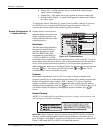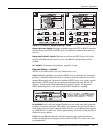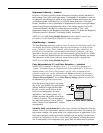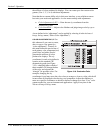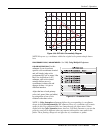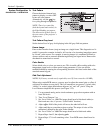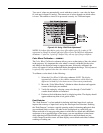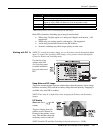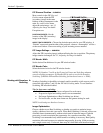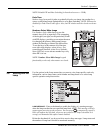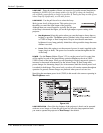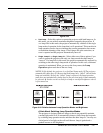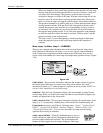
Section 3: Operation
3-42 RPMSP & CSP70-D100U User’s Manual
NOTE: If using Peak Detector with PIP, both images must have the same color space.
Level Detector
The “Level Detector” checkbox enables specific thresholds for blacks and whites—
input levels that fall below a specified Level Value (see below) are displayed as black,
and all others are displayed as white. It aids in Odd Pixel Adjustment. To use:
1. Enable “Level Detector” and display a continuous grayscale.
2. Set “Level Value” to near black (such as 200).
3. Adjust Offsets to minimize area of black stripe.
4. Set “Level Value” to near white (such as 800).
5. Adjust Gains to minimize area of white stripe.
Level Value
Level Value defines the value to be used by the Level Detector in recognizing blacks
and whites. See Level Detector, above.
The single “Option Card” entry in the Configuration menu identifies which optional
input module (a.k.a. cards) is present at
INPUT 5 (Option 1). If the option slot is
empty, the corresponding read-only menu entry does nothing. If there is a module
installed, the corresponding menu entry may activate a submenu of further options
pertaining to that module.
For example, if the Dual SD/HD-SDI module is installed at
INPUT 5 (Option 1). The
Option 1 Card submenu provides controls for configuring the various connections on
this multi-input, multi-output module. As desired for your application, you can define
1) which physical input loops through to which output, and 2) which functional input
(main or PIP signal) loops through to which output.
PIP (Picture-in-Picture) and Seamless Switching are independent but related projector
features that both utilize two image processing paths within the projector. In the case
of Picture-in-Picture, this double processing enables you to display two different
images simultaneously – typically a smaller “secondary” image within a large
“primary” background. In a seamless switch, the double processing essentially occurs
between displays so that a full image relayed from one source can smoothly transform
into a full image from another source. This change can be virtually instantaneous, or
slowed as desired so that the current image appears to dissolve or “fade” into the new
image.
Options for enabling and controlling PIP and Seamless Switching all reside in the
same menu. Note however, that because both features utilize the projector’s double
processing capability, PIP and Seamless Switching cannot be used together. For
example, fading a pair of PIP images into a new display from a different source is not
possible.
For best PIP or Seamless Switching results, use two different signal types* as defined
below. Do not mix two signals of the same type.
System Configuration
'
OPTIONAL INPUT MODULES
3.7 Working with
PIP or
Seamless
Switching



